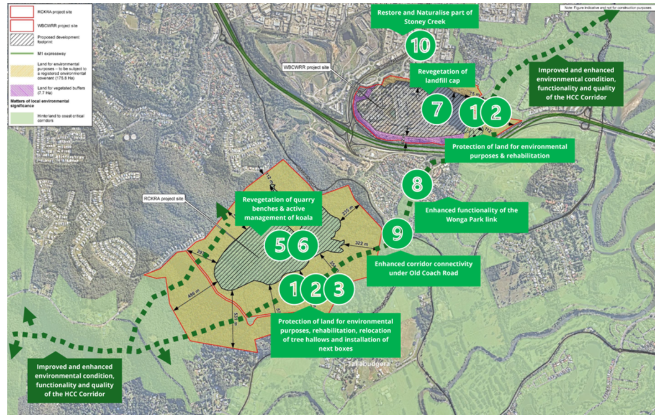- Home
- About Us
-
Project Related Information
- Rehabilitation of the Reedy Creek KRA
- Why is this project different?
- Land Use Context
- Site Baseline Conditions
- Key Project Drivers
- Why Now?
- Development Application Components
- Site Specifics
- What is the Reedy Creek KRA?
- What is the West Burleigh Project?
- Project Benefits
- Timeline - RCKRA & WBCWRR Project
- How will the Reedy Creek Project be built?
- What will happen at West Burleigh?
- Proposed Haul Routes
-
Fact Sheets
- Quarry Industry
- The Quarrying Process
- Recycling and Resource Recovery
- What is non-putrescible waste?
- What is a circular economy?
- What is a Key Resource Area?
- Boral’s Environmental Strategy
- Boral's visual strategy
- Dust Management at Boral
- What is Respirable Crystalline Silica (RCS)?
- Hours of operation - Reedy Creek KRA
- Reedy Creek Project Noise Assessment
- West Burleigh Project Noise Assessment
- Cumulative Noise Impact Assessment
- Reedy Creek Air Quality Assessment
- West Burleigh Air Quality Assessment
- Cumulative Air Quality Impact Assessment
- Blasting and Vibration Fact Sheet
- Visual Amenity Fact Sheet RCKRA
- Visual Amenity Fact Sheet WBCWRR
- Terrestrial Ecology Assessment - RCKRA
- Terrestrial Ecology Assessment - WBCWRR
- Traffic Strategy Fact Sheet
- RCKRA Site Access & Local Road Upgrades
- Contact Us
Boral’s Environmental Strategy
Due to the existing fragmentation and highly disturbed characteristics of the mapped Burleigh to Springbrook - Hinterland to Coast Critical Corridor (HCC Corridor) within this locality, this Environmental Strategy takes a holistic and integrated approach to the way in which Boral will conserve, protect, enhance and manage the identified environmental values that support ecological quality and its functionality within both Project sites and its surrounds.
Focussing on the land identified for environmental purposes on both Project sites and intervening public lands within the HCC Corridor, this Environmental Strategy outlines a suite of environmental outcomes that secure a far better outcome when compared to the existing state and condition, if the development did not proceed.

Having regard to the 56.4ha impact against the 10 environmental outcomes to protect, conserve, enhance and manage the ecological quality and functionality of Boral’s land held for environmental purposes and intervening public lands in the HCC Corridor, the proposed development will deliver a far better outcome when compared to the existing state and condition of both Project sites and surrounds, because:
-
168.4ha4 of land will be protected and conserved under an environmental covenant, which includes the protection and conservation of ecological movement corridors.
-
Existing key threatening processes to the ecological value and function of local native vegetation and riparian communities and associated significant flora and fauna species will be actively managed via weed control, supplementary planting, management of unauthorised public access, management of feral animals, and removal of dumped refuse.
-
The proposed threatened species habitat enhancement that includes extensive koala habitat plantings to increase the local abundance of feed resources for Koalas and Tusked Frog habitat rehabilitation exceeds statutory requirements.
-
The proposed rehabilitation includes a commitment to undertake an early planting regime once the approval is issued to minimise ‘time lag’ impacts between clearing and establishment of koala habitat plantings.
-
The proposed Reedy Creek Key Resource Area disturbance footprint will be enclaved to as soon as practicable to ensure that Koala activity and movement can be managed prior to the clearing of any vegetation.
-
The proposed environmental outcomes include the relocation of existing hollows, installation of additional nest boxes and investment into academic research on Glossy Black Cockatoo uptake of artificial breeding places is provided.
-
The proposed rehabilitation includes planting of threatened flora to extend local distribution and abundance.
-
Contributions to resolving fragmentation between the Reedy Creek Key Resource Area and West Burleigh Construction Waste and Resource Recovery Project sites are proposed including mitigation of movement barriers/bottlenecks on intervening public lands.
-
Contributions to creek restoration to improve riparian vegetation and communities within Oyster Creek and Stony Creek located outside Boral’s landholdings.
-
Future site operations will be underpinned by a series of environmental management plans (including a rehabilitation management plan, fauna management plan, flora management plan and a site-based management plan) all geared toward achieving, managing and maintaining net gains in ecological value and functionality.
This Environmental Strategy has, together with the support of the submitted technical materials, propose a better than best practice environmental outcome for both Project sites and surrounds.
The implementation of this Environmental Strategy as part of the proposed development, collectively demonstrates that both the Reedy Creek Key Resource Area and West Burleigh Construction Waste and Resource Recovery Project have been designed and will operate in such a manner that ensures:
-
critical corridors are accommodated;
-
matters of environmental significance are protected, conserved, enhanced and managed;
-
the environmental assessment hierarchy adopted under the State Planning Policy and State Development Assessment Provisions related to Matters of State Environmental Significant has been satisfied, as the development has avoided impacts where reasonably possible and all impacts have been fully mitigated; and
-
there are no significant residual impacts that require statutory environmental offsets to be provided.


